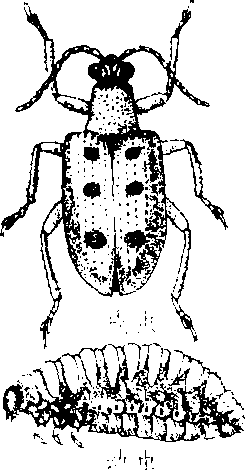枸杞负泥虫tenspotted lema
Lema (Micvolema)decempunctata Gebler,昆虫纲,鞘翅目,叶甲科。分布于华北、华东、西北、西南及湖南;朝鲜、韩国、日本、俄罗斯也有分布。寄主为枸杞。成虫体长约5.6 mm,头、胸蓝黑色,有点刻;鞘翅黄褐色,点刻纵列,有10个黑色斑点,故又名十点叶甲,不同个体间黑点数有差异,有的部分或全部消失。幼虫体长约7 mm,背负污绿色粪便。以成虫和幼虫啃食叶肉。5月份为害重。卵产于叶片上,常10余粒排成“人”字形。成虫具假死性。3月中旬结合中耕,翻耕树冠下土壤可消灭虫蛹。

枸杞负泥虫